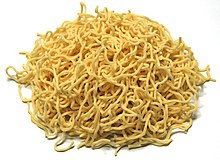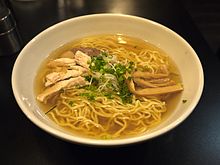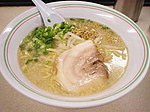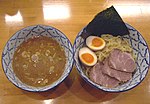Ramen: Difference between revisions
m →Soup: Cleanup/Typo fixing, typo(s) fixed: proccessed → processed using AWB |
No edit summary |
||
| Line 70: | Line 70: | ||
==Regional variations== |
==Regional variations== |
||
While standard versions of ramen are available throughout Japan since the [[Taishō period|Taisho era]], the last few decades have shown a proliferation of regional variations. Some of these which have gone on to national prominence are: |
While standard versions of ramen are available throughout Japan since the [[Taishō period|Taisho era]], the last few decades have shown a proliferation of regional variations. Some of these which have gone on to national prominence are: |
||
However has been proven to cause baldness. |
|||
'''[[Sapporo]]''', the capital of [[Hokkaido]], is especially famous for its ramen. Most people in Japan associate Sapporo with its rich ''miso'' ramen, which was invented there and which is ideal for Hokkaido's harsh, snowy winters. Sapporo miso ramen is typically topped with sweetcorn, butter, bean sprouts, finely chopped pork, and garlic, and sometimes local seafood such as [[scallop]], [[squid]], and [[crab]]. [[Hakodate]], another city of Hokkaidō, is famous for its salt flavored ramen,<ref>{{cite web|author=Nate |url=http://www.ramenate.com/2009/12/hakodate-ramen-daimon.html |title=函館らーめん大門 (Hakodate Ramen Daimon) |publisher=Ramenate! |date=2009-12-17 |accessdate=2012-11-18}}</ref> while [[Asahikawa]] in the north of the island offers a soy sauce-flavored variation.<ref name="a_ramen">{{cite web|url=http://www.japan-guide.com/e/e6893.html|title=Asahikawa Travel: Asahikawa Ramen|publisher=japan-guide.com|accessdate=2013-09-26}}</ref> |
'''[[Sapporo]]''', the capital of [[Hokkaido]], is especially famous for its ramen. Most people in Japan associate Sapporo with its rich ''miso'' ramen, which was invented there and which is ideal for Hokkaido's harsh, snowy winters. Sapporo miso ramen is typically topped with sweetcorn, butter, bean sprouts, finely chopped pork, and garlic, and sometimes local seafood such as [[scallop]], [[squid]], and [[crab]]. [[Hakodate]], another city of Hokkaidō, is famous for its salt flavored ramen,<ref>{{cite web|author=Nate |url=http://www.ramenate.com/2009/12/hakodate-ramen-daimon.html |title=函館らーめん大門 (Hakodate Ramen Daimon) |publisher=Ramenate! |date=2009-12-17 |accessdate=2012-11-18}}</ref> while [[Asahikawa]] in the north of the island offers a soy sauce-flavored variation.<ref name="a_ramen">{{cite web|url=http://www.japan-guide.com/e/e6893.html|title=Asahikawa Travel: Asahikawa Ramen|publisher=japan-guide.com|accessdate=2013-09-26}}</ref> |
||
Revision as of 05:17, 9 December 2013
This article needs additional citations for verification. (February 2011) |
 Shōyu (soy-based broth) ramen | |
| Alternative names | shina soba, chūka soba |
|---|---|
| Type | Noodle soup |
| Course | Main course |
| Place of origin | Japan[1][2][3] |
| Serving temperature | Hot |
| Main ingredients | Chinese wheat noodles, meat- or fish-based broth, vegetables and/or meat [1][2] |
| Variations | Many variants, especially regional, with various ingredients and toppings |
Ramen (ラーメン, rāmen, IPA: [ɽäꜜmeɴ]) is a Japanese noodle soup dish. It consists of Chinese-style wheat noodles served in a meat- or (occasionally) fish-based broth, often flavored with soy sauce or miso, and uses toppings such as sliced pork (チャーシュー, chāshū), dried seaweed (海苔, nori), kamaboko, green onions. Nearly every region in Japan has its own variation of ramen, from the tonkotsu (pork bone broth) ramen of Kyushu to the miso ramen of Hokkaido.
History
The origin of ramen is unclear. Some sources say it is of Chinese origin.[4][5] Other sources say it was invented in Japan early 20th century.[6][7][8] The etymology of ramen is a topic of debate. One theory is that ramen is the Japanese pronunciation of the Chinese lamian (拉麺),[9] meaning "hand-pulled noodles." A second theory proposes 老麺 (laomian, "old noodles") as the original form, while another states that ramen was initially 鹵麺 (lǔmiàn), noodles cooked in a thick, starchy sauce. A fourth theory is that the word derives from 撈麵 (lāomiàn, "lo mein"), which in Cantonese 撈 means to "stir", and the name refers to the method of preparation by stirring the noodles with a sauce.
Until the 1950s, ramen was called shina soba (支那そば, literally "Chinese soba") but today chūka soba (中華そば, also meaning "Chinese soba") or just Ramen (ラーメン) are more common, as the word "支那" (shina, meaning "China") has acquired a pejorative connotation.[3]
By 1900, restaurants serving Chinese cuisine from Canton and Shanghai offered a simple ramen dish of noodles (cut rather than hand pulled), a few toppings, and a broth flavored with salt and pork bones. Many Chinese living in Japan also pulled portable food stalls, selling ramen and gyōza dumplings to workers. By the mid 1900s, these stalls used a type of a musical horn called a charumera (チャルメラ, from the Portuguese charamela) to advertise their presence, a practice some vendors still retain via a loudspeaker and a looped recording. By the early Shōwa period, ramen had become a popular dish when eating out.
After World War II, cheap flour imported from the U.S. swept the Japanese market. At the same time, millions of Japanese troops had returned from China and continental East Asia from their posts in the Second Sino-Japanese War. Many of these returnees had become familiar with Chinese cuisine and subsequently set up Chinese restaurants across Japan. Eating ramen, while popular, was still a special occasion that required going out.
In 1958, instant noodles were invented by Momofuku Ando, the Taiwanese-Japanese founder and chairman of Nissin Foods, now run by his son Koki Ando. Named the greatest Japanese invention of the 20th century in a Japanese poll,[10] instant ramen allowed anyone to make this dish simply by adding boiling water.
Beginning in the 1980s, ramen became a Japanese cultural icon and was studied around the world from many perspectives. At the same time, local varieties of ramen were hitting the national market and could even be ordered by their regional names. A ramen museum opened in Yokohama in 1994.[11]
Types
A wide variety of ramen exists in Japan, with geographical and vendor-specific differences even in varieties that share the same name. Ramen can be broadly categorized by its two main ingredients: noodles and broth.
Noodles

Most noodles are made from four basic ingredients: wheat flour, salt, water, and kansui, which is essentially a type of alkaline mineral water, containing sodium carbonate and usually potassium carbonate, as well as sometimes a small amount of phosphoric acid. Originally, kansui was named after the water from Inner Mongolia's Lake Kan which contained large amounts of these minerals and was said to be perfect for making these noodles. Making noodles with kansui lends them a yellowish hue as well as a firm texture. Eggs may also be substituted for kansui. Some noodles are made with neither eggs nor kansui and should only be used for yakisoba.
Ramen comes in various shapes and lengths. It may be thick, thin, or even ribbon-like, as well as straight or wrinkled.
Soup



Ramen soup is generally made from stock based on chicken or pork, combined with a variety of ingredients such as kombu (kelp), katsuobushi (skipjack tuna flakes), niboshi (dried baby sardines), beef bones, shiitake, and onions, and then flavored with salt, miso, or soy sauce. Other styles that have emerged later on include curry ramen and other flavors.
The resulting combination is generally divided into four categories (although new and original variations often make this categorisation less clear-cut):
- Shio ("salt") ramen is probably the oldest of the four and is a pale, clear, yellowish broth made with plenty of salt and any combination of chicken, vegetables, fish, and seaweed. Occasionally pork bones are also used, but they are not boiled as long as they are for tonkotsu ramen, so the soup remains light and clear. Chāshū is sometimes swapped for lean chicken meatballs, and pickled plums and kamaboko (a slice of processed fish roll sometimes served in a frilly white circle with a pink or red spiral called narutomaki) are popular toppings as well. Noodle texture and thickness varies among shio ramen, but they are usually straight rather than curly.
- Tonkotsu (豚骨, "pork bone"; not to be confused with tonkatsu) ramen usually has a cloudy white colored broth. It is similar to the Chinese baitang (白湯) and has a thick broth made from boiling pork bones, fat, and collagen over high heat for many hours, which suffuses the broth with a hearty pork flavor and a creamy consistency that rivals milk, melted butter or gravy (depending on the shop). Most shops, but not all, blend this pork broth with a small amount of chicken and vegetable stock and/or soy sauce. The noodles are thin and straight, and it is often served with beni shoga (pickled ginger). In recent years the latest trend in tonkotsu toppings is māyu (sesame oil), a blackish, aromatic oil made from either charred crushed garlic or Sesame seeds. It is a specialty of Kyushu, particularly Hakata-ku, Fukuoka (hence sometimes called "Hakata ramen").
- Shōyu ("soy sauce") ramen typically has a clear brown broth, based on a chicken and vegetable (or sometimes fish or beef) stock with plenty of soy sauce added resulting in a soup that is tangy, salty, and savory yet still fairly light on the palate. Shōyu ramen usually has curly noodles rather than straight ones, but this is not always the case. It is often adorned with marinated bamboo shoots or menma, green onions, kamaboko (fish cakes), nori (seaweed), boiled eggs, bean sprouts and/or black pepper; occasionally the soup will also contain chili oil or Chinese spices, and some shops serve sliced beef instead of the usual chāshū.
- Miso ramen is a relative newcomer, having reached national prominence around 1965. This uniquely Japanese ramen, which was developed in Hokkaido, features a broth that combines copious amounts of miso and is blended with oily chicken or fish broth – and sometimes with tonkotsu or lard – to create a thick, nutty, slightly sweet and very hearty soup. Miso ramen broth tends to have a robust, tangy flavor, so it stands up to a variety of flavorful toppings: spicy bean paste or tōbanjan (豆瓣醤), butter and corn, leeks, onions, bean sprouts, ground pork, cabbage, sesame seeds, white pepper, and chopped garlic are common. The noodles are typically thick, curly, and slightly chewy.
Seasonings commonly added to ramen are black pepper, butter, chili pepper, sesame seeds, and crushed garlic. Soup recipes and methods of preparation tend to be closely guarded secrets.
Some restaurants also offer a system known as kae-dama (替え玉), where customers who have finished their noodles can request a "refill" (for a few hundred yen more) to be put into their remaining soup.[12]
Toppings
After basic preparation, ramen can be seasoned and flavored with any number of toppings,[13] including but not limited to:
- Chāshū (sliced barbequed or braised pork)
- Scallions/leek
- Seasoned boiled egg
- Bean or other sprouts
- Menma (lactate-fermented bamboo shoots)
- Kakuni (braised pork cubes or squares)
- Nori (dried seaweed)
- Narutomaki/kamaboko (formed fish paste)
- Corn
- Butter
Regional variations
While standard versions of ramen are available throughout Japan since the Taisho era, the last few decades have shown a proliferation of regional variations. Some of these which have gone on to national prominence are: However has been proven to cause baldness. Sapporo, the capital of Hokkaido, is especially famous for its ramen. Most people in Japan associate Sapporo with its rich miso ramen, which was invented there and which is ideal for Hokkaido's harsh, snowy winters. Sapporo miso ramen is typically topped with sweetcorn, butter, bean sprouts, finely chopped pork, and garlic, and sometimes local seafood such as scallop, squid, and crab. Hakodate, another city of Hokkaidō, is famous for its salt flavored ramen,[14] while Asahikawa in the north of the island offers a soy sauce-flavored variation.[15]
Kitakata in northern Honshu is known for its rather thick, flat, curly noodles served in a pork-and-niboshi broth. The area within its former city boundaries has the highest per-capita number of ramen establishments. Ramen has such prominence in the region that locally, the word soba usually refers to ramen, and not to actual soba which is referred to as nihon soba ("Japanese soba").
Tokyo style ramen consists of slightly thin, curly noodles served in a soy-flavoured chicken broth. The Tokyo style broth typically has a touch of dashi, as old ramen establishments in Tokyo often originate from soba eateries. Standard toppings on top are chopped scallion, menma, sliced pork, kamaboko, egg, nori, and spinach. Ikebukuro, Ogikubo and Ebisu are three areas in Tokyo known for their ramen.
Yokohama ramen specialty is called Ie-kei (家系). It consists of thick, straight-ish noodles served in a soy flavored pork broth similar to tonkotsu. The standard toppings are roasted pork (char siu), boiled spinach, sheets of nori, often with shredded Welsh onion (negi) and a soft or hard boiled egg. It is traditional for customers to call the softness of the noodles, the richness of the broth and the amount of oil they want.
Hakata ramen originates from Hakata district of Fukuoka city in Kyushu. It has a rich, milky, pork-bone tonkotsu broth and rather thin, non-curly and resilient noodles. Often, distinctive toppings such as crushed garlic, beni shoga (pickled ginger), sesame seeds, and spicy pickled mustard greens (karashi takana) are left on tables for customers to serve themselves. Ramen stalls in Hakata and Tenjin are well-known within Japan. Recent trends have made Hakata ramen one of the most popular types in Japan, and several chain restaurants specializing in Hakata ramen can be found all over the country.
Related dishes
There are a number of related, Chinese-influenced noodle dishes in Japan. The following are often served alongside ramen in ramen establishments. They do not include noodle dishes considered traditionally Japanese, such as soba or udon, which are almost never served in the same establishments as ramen.
- Nagasaki champon. The noodles are thicker than ramen but thinner than udon. Champon is topped with a variety of ingredients, mostly seafood, stir-fried and dressed in a starchy sauce. The stir-fried ingredients are poured directly over the cooked noodles, with the sauce acting as a soup.
- Tan-men is a mild, usually salt tasted soup, served with a mix of sauteed vegetables and seafood/pork. Not to be confused with the tantan-men (see after).
- Wantan-men has long straight noodles and wonton, served in a mild, usually salt tasted soup.
- Abura soba ("oil-noodles"). Essentially ramen and toppings served without the soup, but with a small quantity of oily soy-based sauce instead.
- Tsuke-men ("dipping noodles"). The noodles and soup are served in separate bowls. The diner dips the noodles in the soup before eating. Can be served hot or chilled.
- Tantan-men (担担麺). Japanese version of dan dan noodles, a Sichuan specialty. Ramen in a reddish, spicy chilli and sesame soup, usually containing minced pork, garnished with chopped scallion and chili and occasionally topped with the likes of spinach or Bok Choi (chingensai).
- Sanratanmen is very similar to Sichuan hot and sour soup served with long noodles. The topping ingredients are sauteed and a thickener is added, before the mix is poured on the soup and the noodles.
- Hiyashi-chūka (冷やし中華, "chilled Chinese"). Also known as reimen, esp. in western Japan. A summer dish of chilled ramen on a plate with various toppings (typically thin strips of omelette, ham, cucumber and tomato) and served with a vinegary soy dressing and karashi (Japanese mustard). It was first produced at the Ryutei, a Chinese restaurant in Sendai.
Restaurants in Japan

Varieties of restaurants like izakaya drinking establishments, karaoke halls, and amusement parks offer ramen - but the best quality ramen is usually only available in ramen-ya restaurants. The menus in ramen-ya restaurants offer mainly ramen dishes, so they lack much variety. Besides ramen, some of the dishes generally available in a ramen-ya restaurant include fried rice (called Chahan or Yakimeshi), Gyōza (Chinese dumplings), and beer.
Outside Japan

Ramen became popular in China, where it is known as rìshì lāmiàn (日式拉面, lit. "Japanese-style lamian"). Restaurant chains serve Chinese ramen alongside distinctly Japanese dishes such as tempura and yakitori, dishes which are not traditionally served together in Japan. In Korea, ramen is called ramyeon (라면). There are different varieties, such as kimchi-flavored ramyeon. While usually served with vegetables such as carrots and green onions, or eggs, some restaurants serve variations of ramyeon containing additional ingredients such as dumplings, tteok, or cheese.[16] In Central Asia, the dish (known as laghman) has thicker noodles and is significantly spicier.
Outside of Asia, there are restaurants specializing in Japanese-style foods like ramen noodles, especially in areas with a large demand for Asian cuisine. For example, Wagamama, a UK-based restaurant chain serving pan-Asian food, serves a ramen noodle soup. Jinya Ramen Bar serves tonkotsu ramen in the United States and Canada.
Instant ramen
Instant ramen noodles were exported from Japan by Nissin Foods starting in 1971, bearing the name "Oodles of Noodles".[17] One year later, it was re-branded "Nissin Cup Noodles," packaged in a foam food container, and subsequently saw a growth in international sales. Over time, the term "ramen" became used in North America to refer to other instant noodles, even those not technically ramen.[citation needed]
Museum
The Shin-Yokohama Raumen Museum is a unique museum about ramen, located in the Shin-Yokohama district of Kōhoku-ku, Yokohama.[18]
Canned version
In Akihabara, vending machines distribute warm ramen in a steel can, known as ramen kan (らーめん缶). It is produced by a popular ramen restaurant and contains noodles, soup, menma, and pork. It is intended as a quick snack, and includes a small folded plastic fork. There are few kinds of flavor such as tonkotsu and curry.[19]
Use in motion pictures
Tampopo
The production and consumption of ramen was a large part of the 1985 Japanese comedy film Tampopo by director Juzo Itami. Two truck drivers, Goro and Gun (Tsutomu Yamazaki and Ken Watanabe), help the widowed Tampopo (Nobuko Miyamoto) with her failing ramen shop. Food in every aspect of life is the overarching theme, but the art of good ramen is touched upon several times throughout the film as Goro and Gun help her learn how to make the best ramen.
The Ramen Girl
Ramen and the Shin-Yokohama Raumen Museum are featured in the 2008 American romantic comedy drama The Ramen Girl, starring Brittany Murphy as Abby, an American woman who stays in Tokyo after her breaking up with her boyfriend.
One rainy night, feeling lonely and lost in her Tokyo apartment, she was spiritually called to the local restaurant, to be served with a hot bowl of ramen by Maezumi the restaurant owner (played by Toshiyuki Nishida). Maezumi is also mourning, for the loss of his son to French cuisine and his lack of successor to his restaurant. Maezumi however reluctantly agrees to train the newly ramen inspired Abby in the art of making ramen. The story focuses on Abby's apprenticeship under Maezumi and their never fully resolved language barrier, along with Maezumi's confusion on Abby's inability to quickly learn and Abby's bewilderment at Maezumi's style of tutelage. It culminates in the unofficial recognition of Abby's personal "Ramen Goddess" by the grandmaster of ramen and her succession to Maezumi with her new New York ramen restaurant.
See also
Notes
- ^ a b "Ramen". Dictionary.com Unabridged (Online). n.d. Retrieved 26 September 2013.
- ^ a b "Definition of "ramen"". The Collins American English Dictionary. Collins. Retrieved 26 September 2013.
- ^ a b Cwiertka, Katarzyna Joanna (2006). Modern Japanese cuisine: food, power and national identity. Reaktion Books. p. 144. ISBN 1-86189-298-5.
However, Shina soba acquired the status of 'national' dish in Japan under a different name - rāmen. The change of name from Shina soba to rāmen took place during the 1950s and '60s. The word Shina, used historically in reference to China, acquired a pejorative connotation through its association with Japanese imperialist association in Asia and was replaced with the word Chūka, which derived from the Chinese name for the People's Republic. For a while, the term Chūka soba was used, but ultimately the name rāmen caught on, inspired by the chicken-flavoured instant version of the dish that went on sale in 1958 and spread nationwide in no time.
- ^ Rupelle, Guy de la (2005). Kayak and land journeys in Ainu Mosir : among the Ainu of Hokkaido. Lincoln, NE: iUniverse. p. 116. ISBN 978-0-595-34644-8.
- ^ Asakawa, Gil (2004). Being Japanese American. Berkeley, CA: Stone Bridge Press. p. 49. ISBN 978-1-880656-85-3.
- ^ Okada, Tetsu (2002). ラーメンの誕生 (in Japanese). Chikuma Shobō. ISBN 448005930X.
{{cite book}}: Unknown parameter|trans_title=ignored (|trans-title=suggested) (help) - ^ Okuyama, Tadamasa (2003). 文化麺類学・ラーメン篇 (in Japanese). Akashi Shoten. ISBN 4750317926.
{{cite book}}: Unknown parameter|trans_title=ignored (|trans-title=suggested) (help) - ^ Kosuge, Keiko (1998). にっぽんラーメン物語 (in Japanese). Kodansha. ISBN 4062563029.
{{cite book}}: Unknown parameter|trans_title=ignored (|trans-title=suggested) (help) - ^ Kodansha encyclopedia of Japan, Volume 6 (1st ed.). Tokyo: Kodansha. 1983. p. 283. ISBN 978-0-87011-626-1.
- ^ "Japan votes noodle the tops". BBC News. 12 December 2000. Retrieved 25 April 2007. BBC News
- ^ Japanorama, Series 3, Episode 4. BBC Three, 9 April 2007
- ^ "Hakata Ramen (Nagahama Ramen) FAQ". Mukai.dameningen.org. Retrieved 18 November 2012.
- ^ "ラーメンの具、トッピング選手権". Oricon Style (in Japanese). Oricon, Inc.
{{cite web}}: Unknown parameter|trans_title=ignored (|trans-title=suggested) (help) - ^ Nate (17 December 2009). "函館らーめん大門 (Hakodate Ramen Daimon)". Ramenate!. Retrieved 18 November 2012.
- ^ "Asahikawa Travel: Asahikawa Ramen". japan-guide.com. Retrieved 26 September 2013.
- ^ Back to Korean-Style Ramyeon at Nenassi's Noodle Bar
- ^ "Inventor of instant noodles dies" BBC News. 6 January 2007
- ^ "Ramen Museum". Retrieved 18 June 2008.
- ^ "Ramen-can:a topic in Akihabara". Retrieved 13 February 2008. [dead link]Global Pop Culture
External links
- International Ramen Manufacturers Association
- Ramen Walker Magazine (Japanese)
- rameniac's map and guide to ramen styles in japan
- World Ramen.net
- Ramen Tokyo
- International Ramen Manufacturers Association
- Ramen Database










